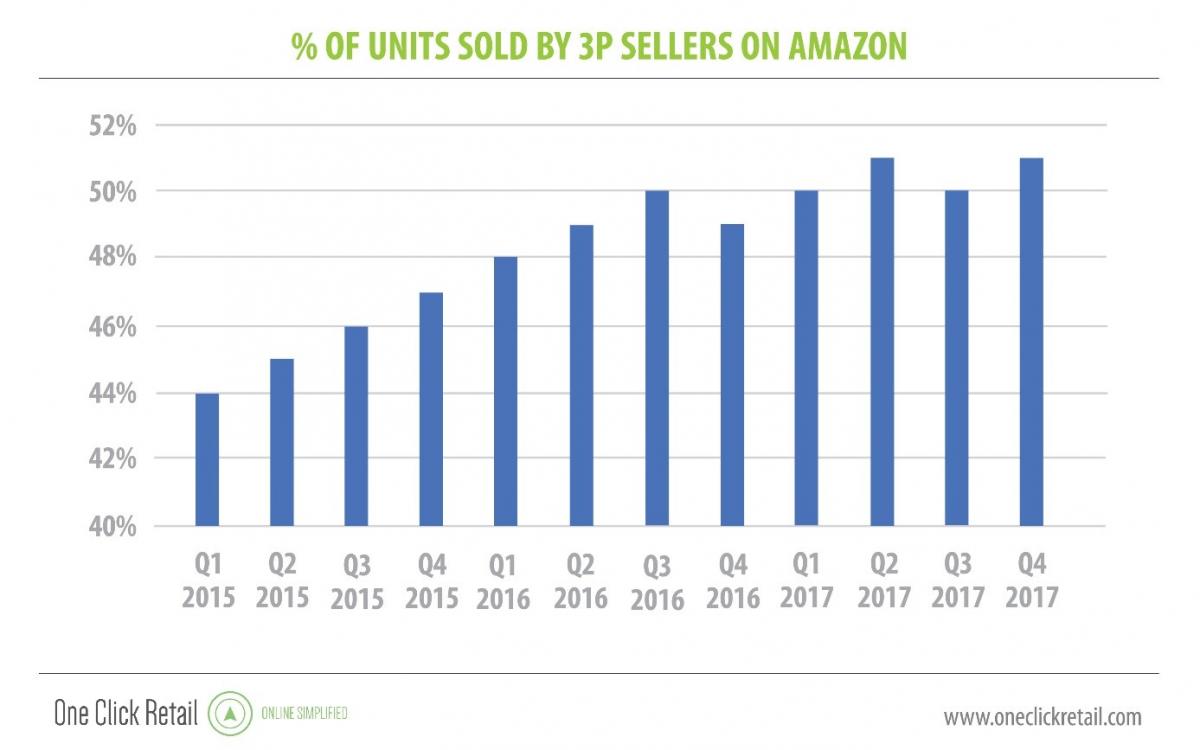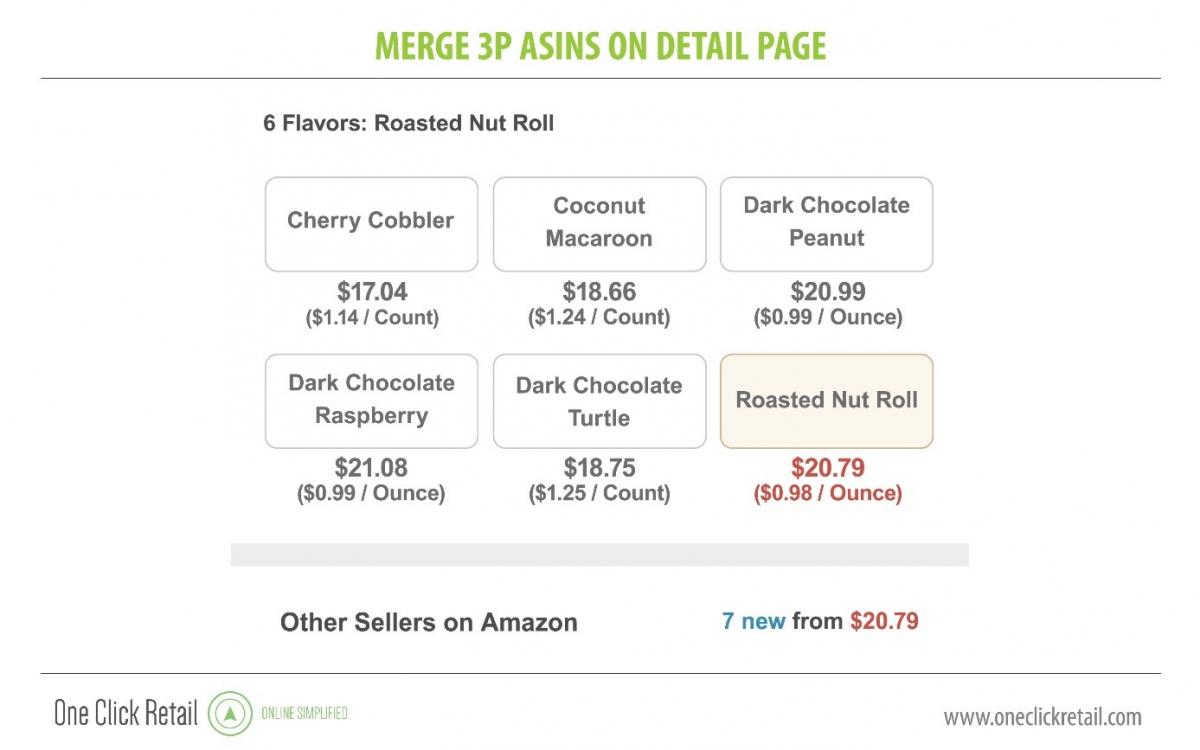By Ben Robins, Insights Manager at One Click Retail
Ecommerce success begins with Amazon. As the biggest online retailer by far, Amazon needs to be at the forefront of any brand's ecommerce strategy. However, when you start working with Amazon as a first party seller, you may face a unique problem: competition from third parties selling your products.
What Is a Third Party Seller?
-
A first party seller (1P) is a brand manufacturer that sells inventory directly to Amazon, who then sells it to the customer. For shoppers, these items appear on the platform with the label "Ships from and sold by Amazon.com". In this case, Amazon is the merchant of record (MOR), meaning the legal owner of the inventory prior to it changing hands with the consumer.
-
A second party (2P) seller is an Amazon supplier that is not the manufacturer of the product; Amazon is the MOR but they sourced the inventory through a reseller. 2P is less common and is typically used by Amazon to supplement their inventory. These items also appear with the label "Ships from and sold by Amazon.com".
-
A third party seller (3P) uses Amazon as a marketplace to sell directly to consumers; the 3P is the MOR. These items appear with the labels "Fulfilled by Amazon" or "Ships from and sold by (retailer)". Third parties acquire their inventory by purchasing it directly from the manufacturer, buying it from other retailers, or may be selling goods that are stolen or counterfeit.
Every sale made by a third party is a sale that isn't credited to you; 3Ps sell your products for profit but have no stake in your brand integrity. According to PlanetRetail RNG, the 3P market is forecast to "account for 64% of global ecommerce sales added through 2022" (PRNG: Winning with 3P Marketplaces), and supporting their estimate is the fact that the percentage of products sold on Amazon by 3Ps is steadily increasing.

For most brand manufacturers, their products were available from 3Ps long before they began selling directly to Amazon. Particularly for relatively new 1P sellers, Amazon's search algorithms will rank 3P items higher because they likely have more customer reviews and higher sales. But you have some distinct competitive advantages, which you can use to manage 3P competitors and control your brand on Amazon.
Winning the Buy Box
Regardless of whether an item is sold by a first or third party, if it controls the buy box then it suggests to shoppers that this item is trustworthy and Amazon-approved. Let's call this effect the "buy box bias" – if a 3P seller controls the buy box they will take potential sales away from the 1P brand. There are two main threats that can cause you to lose your buy box: being undercut on price or going out of stock.
The former is referred to by Amazon as "Lost Buy Box due to price". The benchmark to aim for is to keep your LBB due to price rate below 3%. Above that point and it can have a damaging long-term effect on your search ranking and conversion.
The latter is when a 3P seller can win the buy box and “take control” of your curated detail page because your product is out of stock in the Amazon Fulfillment Center. Creating a reliable supply chain is vital to winning online – if you can't fulfill an order there is always someone else waiting to do so.
To maintain control of the marketplace, the most important things you can do is to control your supply chain and to manage product variants on Amazon.
Controlling the Supply Chain
To limit 3P competition, keeping a tight control over your supply chain is key. Start by identifying the 3P merchants that are selling your products on Amazon. You can then begin to identify where they are sourcing their stock – closing this logistical loop can prevent 3Ps from getting a hold of cheap versions of your product.
-
Limiting promotions. One common pattern we see frequently is a significant uptick in Amazon 3P sales following a promotional period. When a brand offers a steep discount, resellers can take the opportunity to buy in bulk at heavily reduced prices – when you do this you are essentially flooding the market with cheap stock. The result? When you come off the promotion, 3rd parties can undercut you on price for months to come. The solution is to set limits: whenever you are running a promotion on Amazon or elsewhere, introduce "per-customer" limits to ensure individual shoppers can only buy up to a reasonable specified amount.
-
Catching counterfeiters. Another risk is counterfeit merchandise. Keep a close eye on the Amazon search page for copyright or intellectual infringements so that you can report them if you notice anything amiss (Amazon's Transaction Risk Management Team within Amazon is dedicated to preserving customer trust).
-
Brand gating. If you've done what you can to control the supply chain but you are still losing the buy box due to price, try brand gating. You can negotiate with Amazon to set a barrier or wall around your brand to stop 3Ps from selling through your listings, which can be very effective in discouraging resellers and counterfeiters from targeting your brand.
Managing Product Variants
Amazon does not like to see duplicate pages in search results, but it is up to brands to report and merge the appropriate ASINs in order to remove duplicates. You can improve your search rank and conversion by combining your own product variants – different pack sizes, colors or flavors – onto a single page, allowing consumers to easily browse through all the options available. This maximizes the consumer experience by allowing shopping to be done on one main page, improves your search performance by collecting total sales, and collects all of product reviews in one place to increase any given variant's total number of reviews.
Much the same as when you combine your own product variations, you can also request that Amazon merges 3P ASINs into your detail page. Not only can this further increase your search ranking, it also gives you a more control of your brand by overriding any 3P detail pages which may have poor content, out of date images, and inaccurate product descriptions. More importantly, merging 3P items into your detail pages means that you can prevent them from showing up in search results at all, instead confining them to the "Other Sellers on Amazon" section of the buy box as in the example below.

More than half of all online product searches begin on Amazon and 80% of the time online advertising correlates to higher offline sales, so controlling the space can have a huge impact on your bottom line both on Amazon and across all retailers. You will not be able to eliminate every single third party seller via the means mentioned above, but it is essential that you use all tools available to you. Controlling your product page, maintaining strong performance in search results, carefully guarding availability and nurturing a strong presence of reviews all directly translate to higher sales. Regardless of whether there is 3P equivalent of a particular item (and there almost always is), brands need stay on top of these key metrics to win on Amazon and in the online channel as a whole.



